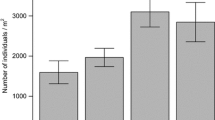Abstract
Predation by small fish and invertebrates has been shown to influence wetland macroinvertebrates in various ways and to various degrees in different types of wetlands. I sought to determine whether predation could be a significant factor causing invertebrate-community variation along an elevation gradient in a Lake Huron coastal wetland. I conducted three month-long predator exclusion/inclusion field experiments in the wet-meadow portion of the wetland, where the water was shallow (20–30 cm) and hypoxic, and mudminnows and dragonfly nymphs were the most-abundant predators. Experiment results showed that mudminnows caused a significant decrease in abundance and diversity, but did not substantially alter relative proportions of different macroinvertebrate taxa. NMDS ordination confirmed this result. Meanwhile, dragonfly nymphs, even at high density, had no significant effects on macroinvertebrate abundance, diversity, or relative abundances of different taxa. These results suggest that, while fish are capable of reducing prey abundance, neither they nor dragonfly nymphs played a significant role in causing the wet-meadow macroinvertebrate assemblage to differ from others in this wetland.







Similar content being viewed by others
References
Batzer DP (2013) The seemingly intractable ecological responses of invertebrates in North American wetlands: a review. Wetlands 33:1–15
Batzer DP, Pusateri CR, Vetter R (2000) Impacts of fish predation on marsh invertebrates: direct and indirect effects. Wetlands 20:307–312
Benke AC (1976) Dragonfly production and prey turnover. Ecology 57:915–927
Cobbaert D, Bayley SE, Greter J (2010) Effects of a top invertebrate predator (Dytiscus alaskanus; Coleoptera: Dytiscidae) on fishless pond ecosystems. Hydrobiologia 644:103–114
Czarnecka M, Pilotto F, Pusch MT (2014) Is coarse woody debris in lakes a refuge or a trap for benthic invertebrates exposed to fish predation? Freshwater Biology 59:2400–2412
Diehl S (1992) Fish predation and benthic community structure: the role of omnivory and habitat complexity. Ecology 73:1646–1661
Gathman JP, Burton TM (2011) A Great Lakes coastal wetland invertebrate community gradient: relative influence of flooding regime and vegetation zonation. Wetlands 31:329–341
Hanson MA, Riggs MR (1995) Potential effects of fish predation on wetland invertebrates: a comparison of wetlands with and without fathead minnows. Wetlands 15:167–175
Hornung JP, Foote AL (2006) Aquatic invertebrate responses to fish presence and vegetation complexity in western boreal wetlands, with implications for waterbird productivity. Wetlands 26:1–12
Johnson DM, Pierce CL, Martin TH, Watson CN, Bohanan RE, Crowley PH (1987) Prey depletion by odonate larvae: combining evidence from multiple field experiments. Ecology 68:1459–1465
Johnson DM, Martin TH, Crowley PH, Crowder LB (1996) Link strength in lake littoral food webs: net effects of small sunfish and larval dragonflies. Journal of the North American Benthological Society 15:271–288
Kornijow R, Measey GJ, Moss B (2016) The structure of the littoral: effets of waterlily density and perch predation on sediment and plant-associated macroinvertebrate communities. Freshwater Biology 61:32–50
Larson DJ (1990) Odonate predation as a factor influencing dytiscid beetle distribution and community structure. Quaestiones Entomologicae 26:151–162
Laske SM, Rosenberger AE, Kane WJ, Wipfli MS, Zimmerman CE (2017) Top-down control of invertebrates by Ninespine stickleback in Arctic ponds. Freshwater Science 36:124–137
Lombardo P (1997) Predation by Enallagma nymphs (Odonata, Zygoptera) under different conditions of spatial heterogeneity. Hydrobiologia 356:1–9
Magnusson AK, Williams DD (2009) Top-down control by insect predators in an intermittent pond – a field experiment. Annales de Limnologie – International Journal of Limnology 45:131–143
McParland CE, Paszkowski CA (2006) Effects of small-bodied fish on invertebrate prey and foraging patterns of waterbirds in Aspen parkland wetlands. Hydrobiologia 567:43–55
Nasmith LE, Tonn WM, Paszkowski CA, Scrimgeour GJ (2012) Limited effects of stocked trout on littoral invertebrates in boreal foothills lakes. Canadian Journal of Fisheries and Aquatic Sciences 69:178–190
Pierce CL, Hinrichs BD (1997) Response of littoral invertebrates to reduction of fish density: simultaneous experiments in ponds with different fish assemblages. Freshwater Biology 37:397–408
Pitcher KA, Soluk DA (2018) Fish presence and inter-patch connectivity interactively alter the size of emergent insects in experimental enclosures. Ecosphere 9:1–17
Tate AW, Hershey AE (2003) Selective feeding by larval dytiscids (Coleoptera: Dytiscidae) and effects of fish predation on upper littoral zone macroinvertebrate communities of arctic lakes. Hydrobiologia 497:12–23
Thorp JH, Cothran ML (1984) Regulation of freshwater community structure at multiple intensities of dragonfly predation. Ecology 65:1546–1555
Turner AM, Chislock MF (2007) Dragonfly predators influence biomass and density of pond snails. Oecologia 153:407–415
Wellborn GA, Robinson JV (1991) The influence of fish predation in an experienced prey community. Canadian Journal of Zoology 69:2515–2522
Wohlfahrt B, Mikolajewski DJ, Joop G, Suhling F (2006) Are behavioural traits in prey sensitive to the risk imposed by predatory fish? Freshwater Biology 51:76–84
Woodward G, Hildrew AG (2002) The impact of a sit-and-wait predator: separating consumption and prey emigration. Oikos 99:409–418
Zimmer KD, Hanson MA, Butler MG (2000) Factors influencing invertebrate communities in prairie wetlands: a multivariate approach. Canadian Journal of Fisheries and Aquatic Sciences 57:76–85
Acknowledgments
This paper is dedicated to the late Thomas M. Burton, Ph.D., whose advice and support made this work possible. Tom and many of his students have contributed greatly to our understanding of the ecological communities of the coastal wetlands of the Great Lakes. This research benefited from logistical support provided by The Nature Conservancy (Michigan Chapter) and community cooperation coordinated by the Les Cheneaux Economic Forum. I am grateful for early manuscript reviews by Katya Kovalenko, Ph.D. and Ms. Jamie Bucholz.
Author information
Authors and Affiliations
Corresponding author
Additional information
Publisher’s Note
Springer Nature remains neutral with regard to jurisdictional claims in published maps and institutional affiliations.
Rights and permissions
About this article
Cite this article
Gathman, J.P. Do Predators Structure Wetland Macroinvertebrate Assemblages? Different Effects of Mudminnows and Dragonfly Nymphs in Field Experiments. Wetlands 40, 143–152 (2020). https://doi.org/10.1007/s13157-019-01169-4
Received:
Accepted:
Published:
Issue Date:
DOI: https://doi.org/10.1007/s13157-019-01169-4




